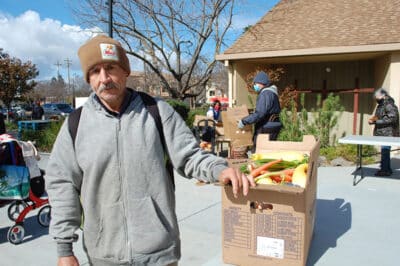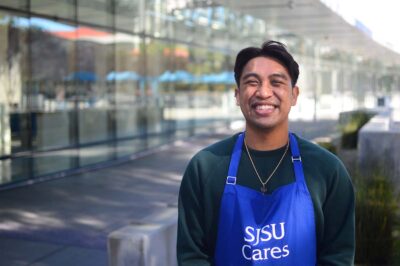College students in Silicon Valley are seeking a better life for themselves and their families through higher education, but don’t have the money to meet their basic needs in the process. Many discover that trying to be a full-time student while having a full-time job to pay for necessities is almost impossible and contributes to college hunger and food insecurity. Graduating college can make a substantial difference to a household’s overall income. According to the 2024 Silicon Valley Index, Silicon Valley workers with a bachelor’s degree earned an estimated $57,000 more than those with only a high school diploma in 2022.
This means food insecurity in college students jeopardizes not only their degrees but also their future earning potential.
What are college students saying about college hunger ?
When speaking with our clients who are college students, the majority say they are newly financially independent, whether by choice because they don’t want to burden their parents with another expense or because their families do not have the means to contribute to their education.
To afford living in Silicon Valley, college students quickly realize they somehow need to bring in a full-time paycheck while balancing a full-time class schedule and all it entails, including studying, unpaid internships, service learning and student teaching, just to afford tuition, housing, books, bills, meal plans and food. Sadly, college hunger is on the rise. Only recently, the California Student Aid Commission published a revealing report on the state of food insecurity among college students. The 2022-2023 survey findings showed a staggering 66% of students applying for student aide experienced food insecurity, a substantial rise from the 39% reported in the 2018-2019 academic year.
Not only are students covering their own expenses, but many are also covering the financial needs of their families and loved ones. The college students in the area that can’t afford to live on their own are living with their families off-campus while commuting to class.

Many Mouths to Feed
When Hansaint, or Han, stopped eating his portion of food to ensure his eight family members were fed, he knew he needed help. Han is a 22-year-old student at College of San Mateo, and he attends his school’s weekly free pantry program to get food for himself and his family.
“I live with a lot of people. There are a lot of mouths to feed. I am always trying to think of some way to cook for my entire house. Usually, it would be soup. Sometimes, I would increase the water content so it would feel like there was more.”
As a full-time student, Han knows first-hand the importance of having nutrient-dense food in your body. He had been surviving on candy and cheap fast food and noticed he was always feeling slightly angry. When Han started receiving free food provided by Second Harvest, he realized how his mood improved, and he could think more clearly.
What Our College Partners Are Saying About College Hunger
Victoria, the Student Affairs Case Manager at San Jose State University, says the staff at the Spartan Food Pantry try hard to combat the message of the starving student:
“We know students say, ‘I’m just going to be broke and eat ramen because that’s all I can afford.’ It doesn’t have to be that way. Students should be getting nutritious food. And we want to normalize assistance for getting those options.”
Các Spartan Food Pantry is a walk-in, full-service, staffed food assistance program offering non-perishable goods, fresh produce, and refrigerated items to eligible SJSU students. SJSU defines those in need as students who have limited or uncertain access to nutritious and safe foods because of a lack of money and other resources. Much of the food the Spartan Pantry distributes is provided by Second Harvest.
Money Saving Strategies
This past winter 285 college students reached out to our Food Connection team seeking food assistance and support. We often hear about the money-saving strategies students use while pursuing higher education:
Students are…
- – foregoing meal plans.
- – seeking CalFresh support.
- – eating fast, nutrient-poor foods to save money.
- – skipping meals.
- – stretching meals to make them last longer.
- – visiting their college pantries or free grocery distributions.
- – choosing to live at home to save money on rent.
Food Insecurity Affects Families Too
Many students are turning to CalFresh to help feed themselves and their loved ones.
When students reach out to us looking for support, they are also speaking up on behalf of the people they live with, and they are hoping to bring home enough support that will benefit their entire household.
“CalFresh is the solution for the general public because it gives you the most flexibility,” says Kelly Chew, Second Harvest’s Director of Services. “They can use CalFresh at so many stores and even online. CalFresh is the best solution to addressing hunger in general. It is supplemental to our food.”
CalFresh emergency allotments were implemented during the pandemic and granted recipients the maximum monthly benefits for their household size. The end of emergency allotments in February 2023 meant that every household receiving CalFresh lost at least $95 a month in benefits, and families flooded our hotline looking for other forms of support. Many clients shared that they watched their monthly CalFresh benefits fall drastically (some went as low as $23 a month), despite record inflation and high prices.
College students felt this burden too. The applications process took a significant amount of time for students who were balancing full-time school schedules, studying and working.
“Students find navigating the application forms, gathering required documentation like income verification and understanding student eligibility criteria challenging,” says Alexis Takagi, the Basic Needs Coordinator in the Office of Student Life at Santa Clara University. “As a response to the complex process, students prefer to meet with me or through Second Harvest to get hands-on CalFresh application support.”
SCU is an Outreach Partner Engagement Network (OPEN) partner of Second Harvest. OPEN helps us expand our reach to communities where we may not have food distributions. As an OPEN partner, SCU supports students with needs related to food insecurity. Second Harvest provides the university with outreach materials, tools to assist community members with food assistance programs (including CalFresh, free groceries and ready-to-eat meals) or other support services, training on those programs, and opportunities to network with other OPEN partners.
Food Connection Hotline and CalFresh
Patrick Manigque has been working on the Food Connection Team for over seven years and can support clients in English and Tagalog.
Students lament that a lot of time and effort is needed to apply for CalFresh, and the allotments are just not enough. After every application is submitted, a phone interview with a CalFresh liaison must be scheduled to review the case.
“My college student CalFresh applications have had a very low approval rate,” says Patrick. “Many say they are missing their interview calls with the county.”
“The difficult thing about CalFresh support calls, especially if their income just shrunk, and you do a calculation, sometimes they still won’t qualify. That’s the most difficult thing to tell a client when you know they are struggling, to say they are still earning too much for the program.”
Patrick – Food Connection Coordinator
“Students have a pretty busy schedule. Sometimes when they request our help to apply for CalFresh, they will type out the schedule that they have so we know when we can contact them.”
Jennery – Food Connection Field Specialist
“It really helps when you can offer to sign up a client to a food distribution site when they don’t qualify for CalFresh.”
Patrick – Food Connection Coordinator
“I feel like, when clients call us, they feel relief because we can provide food for them. They have to be worried about so many other things in their life, but food is not one of them.”
Jennery – Food Connection Field Specialist

Supporting Our College Communities
Han wants to help people as much as he can to give back that same spirit of support he remembers receiving when times were tough.
“I want to support people that may say, ‘I’m a little shy and a little nervous to get free groceries,’ because you know how it is when people are a little bit prideful.”
Han recently changed his major from computer science to fire service. He said he wanted to become a firefighter to utilize his field to help others.
College of San Mateo serves an average of 1,300+ households a month at their drive-thru distribution, and more than 1,500 students a month through their pantry, which is open daily. Han is proud that they give away most of the pantry’s food stock by the end of the week. It means students aren’t afraid to seek food assistance and they are getting fed.
Alexis reflected on what it means to support college students on SCU campus:
“There is no more rewarding feeling than when students show me their EBT card with a smile and relief that this is one less expense they have to worry about,” says Alexis. “When students tell me about their wins, that they did their CalFresh interview, that they received their benefits, and the impact it has had on their well-being and academics, that is what motivates me to continue reaching students and ensuring that they know these resources are available for them. Their success is my success.”



